|
FAQs on Sebae Anemone
Identification
Related Articles: Heteractis
crispa/Sebae Anemones, Bubble
Tip Anemones, Anemones,
Cnidarians, Colored/Dyed Anemones,
Related FAQs: Anemone ID 1, Anemone ID 2, Anemone ID 3, Anemone ID
4, Anemone
ID 5, Anemone ID
6,
Anemone ID 7,
Anemone ID 8,
Anemone ID 9, Anemone ID 10,
Anemone ID
11,
Anemone ID 12, Anemone ID 13, Anemone ID 14, Anemone ID 15,
Anemone ID
16, Anemone ID 17, Anemone ID 18, Anemone ID 19,
Anemone ID 20,
Anemone ID 21, Anemone ID 22, Anemone ID 23, Anemone ID 24, Anemone ID 25, Anemone ID 26, Anemone ID 27, Anemone ID 28, Anemone ID 29, Anemone
ID 30, Anemone ID 31,
Anemone ID 32,
Anemone ID 33,
Anemone ID 34, Anemone ID 35,
Anemone ID 36, Anemone ID 37, Anemone ID 38, Anemone ID 39, Anemone ID 40,
Anemone ID 42,
Anemone ID 43, Anemone ID 44,
Anemone ID 45,
&
Cnidarian
Identification,
Related FAQs: Sebae
Anemones 1, Sebae Anemones 2,
Sebae Anemones 3, Sebae Behavior, Sebae Compatibility, Sebae Selection, Sebae Systems, Sebae Feeding, Sebae Disease, Sebae Reproduction,
Anemones, Anemones 2,
Caribbean
Anemones, Condylactis,
Aiptasia
Anemones, Anemones and
Clownfishes, Anemone
Reproduction, Anemone
Lighting, Anemone
Identification, Anemone
Compatibility, Anemone
Selection, Anemone Behavior,
Anemone
Health, Anemone
Placement, Anemone
Feeding, Heteractis malu,
Bleached Sebae Anemone and Maroon mis-match
|
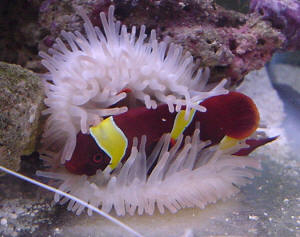
|
 |
New Print and
eBook on Amazon:
Anemone Success
Doing what it takes to keep Anemones healthy long-term
by Robert (Bob) Fenner
|
|
Follow up on previous anemone ID FAQ
2/15/12
Hello again!
This question is primarily directed towards Bob Fenner, if he is
available..
<Yo>
We spoke just a few weeks ago regarding a baby anemone I received
at a LFS.
I wanted to follow up with some additional information I have
learned as well as a couple of questions, if you have time
:0)
The original question is located here: (along with photos)
http://www.wetwebmedia.com/btaidfaqs.htm
The final verdict at the time seemed to be that it was indeed a
baby BTA, however I just read on another posting something
surprising.. That BTAs are the only anemone without verracae? Is
this true?
<Verrucae? No>
If that is the case then I do not have a BTA because he has many
rows of very white verracae bumps under himself, is the umbrella
part called the oral disc? (The only place they are not is on the
stalk of his base, the longer part.) He sticks those little white
bumps to everything, it seems to be the primary method of how he
attaches. I was able to get a very close look this morning when
he decided to release from his rock on the bottom of the tank
perhaps in search of greener (brighter?) pastures. I helped him
float into a spot near the top of the tank with a nice crevice,
and he attached onto it immediately, so hopefully he will like
it. I seem to be having a hard time getting him to eat, however.
A few weeks ago I was forced to tear apart some of my tank and
just removing the live rock then putting it back in started a
mini cycle. My little anemone was not impressed with the
situation whatsoever and immediately shriveled up to hide and
stopped eating. He has not expelled his Zooxanthellae, however,
thankfully his color is still very good. The base is a creamy off
white with rows of white bumps right under his disc(?) and his
tentacles are still brown with bright purple tips. I hope he will
come around soon, it has been weeks (water parameters are
excellent) but he is still small. I hope the move to the top of
the tank will help. Oh btw I also noticed a few days ago (while
on his previous bottom of the tank rock) that he was being
literally barraged by many amphipods. I looked very closely and
it did not look like they were biting him at all, they were just
crawling all over him, in and out of his tentacles.. Is this
anything you have ever heard of??
<Yes>
No wonder the poor thing wanted to move... What can I do to help
with his anorexia?
<Read... on WWM, elsewhere, re feeding large
Actinarians>
Below I am attaching a photo I found of an anemone with a
very similar looking base.
<... this photo is stolen then I take it; not
posted>
This is obviously not my anemone, it is just a picture I found
online.. I do not even know what kind of anemone is even in the
picture, but if you imagine a base like that on a teeny tiny
2-3" purple baby nem that is exactly what I have... Any
ideas?
<Yes; keep reading>
Thank you for all of your help!! :-D
<Cheers, B>
Clarification! 2/15/12
I just now sent an email with a new question and a link to a
previous WWM FAQ. I forgot to specify that the question I was
referring to is the very first one on the page. Sorry if there
was any confusion!
Thanks~
Leah
<Welcome>
Picture number 2 ~ baby purple mystery anemone
2/15/12
Hi again,
(........cont. from previous email today)
Here is a photo of the poor thing today. He looks just absolutely
awful!!
although I did take this immediately after he finished purging
(the mouth is not usually that wide open) anyways, I wanted you
to get a fresh look at him now, after the stress of moving and
after the tank reboot I accidentally caused (that is what
stressed him out badly, it was completely 100% my fault) it looks
like he has retracted some of his tentacles (they're not as
thick as before) and it also seems like he is always trying to
hide inside if his base, if that even makes sense... He
frequently curls up inside of his edges only letting his
tentacles stick out~ keep in mind that this little guy is
seriously tiny (like the size of a half dollar) so he must be a
strong one. What do you make of all of this? And what species is
he?
<Might be a Heteractis crispa. See WWM... B>
Two more pics....
From another angle.. And a close up of his mouth. What is going
on in there? I know he just purged, but I've never seen it
look like this before :(
http://www.wetwebmedia.com/marine/inverts/cnidaria/anthozoa/heteraccrispa.htm
and the linked files above>
|
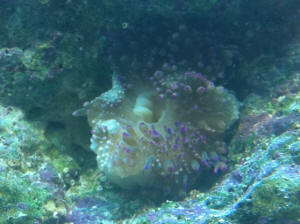 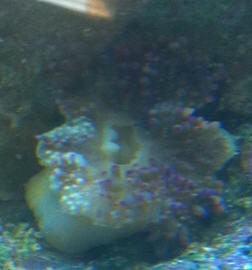 %20leah%203.jpeg) |
|
Re: Follow up on previous anemone ID FAQ
2/15.12
Thank you Bob! Sorry for sending so many emails~ lol ~ I kept
having afterthoughts :-)) I appreciate all of your help!
~Leah
<No worries. Do read re Sebaes... B>
Re: Picture number 2 ~ baby purple mystery anemone
2/15.12
Hey Bob,
I just was doing the reading you suggested on Heteractis Crispa,
yep, it does look and sound a lot like mine... I have to admit I
am a bit discouraged because It really does sound like this
little guy was set up for failure from the very beginning!! Why
would they even collect such a tiny/fragile little thing out of
the ocean when they are notoriously so difficult to care for?
<The simplest of answers... serendipity usually rules... is
that people will pay for them>
Well... I will do my best to help him grow, with the help of
expert advice he will hopefully have a good shot! I had a few
slip ups... I'll keep you updated on his progress!
~Leah
<Is one of the hardier commensal/symbiotic anemone species for
aquarium use... B>
|
|
Anemone Identification - Sebae? 12/2/10
Hello, and thank you in advance. You have been of help for me in
the past, and I want to thank you all for the time you donate to
help others, such as myself.
Your site has been a huge resource and has been so helpful.
<Very glad that we have helped you>
I purchased this anemone for a very big discount at my pet store.
He had been there two months. He was so white, he looked like
glass...see-through. His size initially, was about 1.5"
across and he was flat, without much of an extension where his
tentacles are. The petstore helper said that he had no idea
what
it was, but it had arrived as a Sebae, but had not had a good
time...he discounted it for $10 if I wanted it, and I took the
thing home.
Well, he has grown, and his coloration is increasing, slowly, and
I have had him about 3 months. He is now a light pinkish purple,
with bright blue tips.
<I see this... unusual coloring>
I would like to see his tentacles get longer, but they don't
seem to and they don't seem to be full as the bubble tipped
anemone I have had in another system.
This little thing is about 4" across, maybe 5", now and
it is not white anymore,
but it's still not dark, either.
<Will likely continue to change, intensify/darken with
time>
My system is under 250w HQI 20k lighting. He is approximately 1
foot from that bulb, and he is also given T5 lighting, as a
supplement, only the actinics, as I need to purchase new 14k t5ho
bulbs for the other two, however it is helping...not as fast as
I'd like to see it, but he looks improved.
I don't have any pictures of when he arrived, however, I have
some photos I snapped today which I'd like your opinion
on.
I have been through your entire site. I read all the differences
I could find between the H. Crispa and H. Malu. I still can't
identify him properly and in order to get him the right
clownfish, I'd like to have an idea what type I should be
searching out...I don't particularly like the Clarkii, so I
am hopeful he can accept other types.
<Yes, can>
I was thinking of a skunk pair...but let's see what you
determine him to be, and go from there.
<I do think this is a Heteractis crispa, a "Sebae"
as you state>
His tips aren't pink, they are blue.
<At least they are "dotted" at the tips; a
definitive characteristic>
His coloration is a very light lavenderish-tan,
<As I say, strange to me>
and he lives on top of the reef, and has finally adjusted to the
lighting after all this time, just this month. His hiding days
are gone, thank goodness. He, at first, soaked up light, and then
went into the reef and I
was afraid he had died, but he came out earlier this month and
continues eating Krill and Mysis Shrimp, and he is now up near
the light, soaking and enjoying it.
<Good>
I see him spread out more. My Maroon ignores him, although she
swims over and looks...she prefers my frogspawn over him,
therefore I am pretty sure it's a Sebae, but I really value
your opinion.
Thank you again, and I hope that you can help me identify
him.
Photo #1 is the anemone from the top of the tank, showing his
coloration, because the flash bleaches him out somewhat.
<Ah yes>
Photo #2 is from the side of the tank and yes, I see the algae
behind him...I am picking it out soon as I get this photo out to
you! Lol. :)
Renee
<Thank you for sharing. Bob Fenner>
|
|
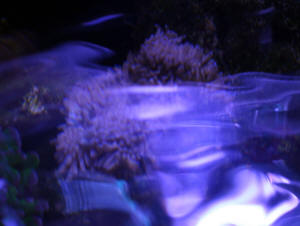 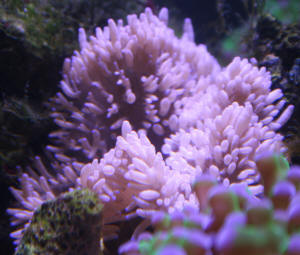
Re: Anemone Identification -
Sebae? 1/28/11
Hello,
<Hi there>
I wanted to send another update as to the anemone. It's
now January 27.
This is the anemone today.
My question is: he is really sticky now when I feed him. Is
this normal?
I cannot locate any other Sebaes like this online.
<Not normal for the species... and this may well not be
Heteractis crispa>
Is this a normal coloration and is this indeed still a Sebae?
He lives on top of my reef right under the 250 HQI 20k
bulb.
I have had him since September, 2010.
Thank you in advance for answering additional questions.
Renee
PS- New image attached.
<Can you send along some images of the basal disc (foot),
pedicle (stalk)? Bob Fenner> |
|
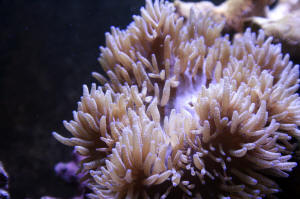
|
|
Re Anemone ID
1/28/11
Hi Bob,
<FD>
You sent me a request to see the foot of my Sebae and here
are the best images I can take. I would include the other
letter, but for some reason, I can't find it.
<No worries>
As you notice, I have included an additional close-up of
the tentacles to help as well.
I am pretty sure it's a Sebae, but I am not finding
many with this coloration.
<I do NOT think this is H. crispa... these lack the
verrucae evident on your specimen... and the tentacle size,
markings are all wrong>
When I sent my note last night, I thought I had it since
September, but looking at images, I found out it's
since late July, 2010, so we have had it around six months,
and its recovery has been very slow.
He eats Krill and Mysis shrimp so I don't think they
are causing the coloration.
<May well be influencing>
He is very lavenderish with a grayish brown tint.
Thank you once again...am looking forward to your
diagnosis.
Renee
PS- What is H. Aurora and why am I not finding anything on
it in here, whereas online I am finding many things about
it? Is it the same as Malu or Crispa?
<No... Please read here: http://wetwebmedia.com/beadanemfaqs.htm
and here:
http://wetwebmedia.com/marine/inverts/cnidaria/anthozoa/anemones.htm
and do the long read and possibly send your pix to Daphne
Fautin at her site:
http://hercules.kgs.ku.edu/hexacoral/anemone2/index.cfm
Bob Fenner, who clearly does NOT know what Actinarian this
is>
|
|
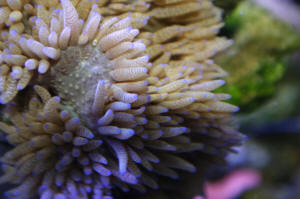 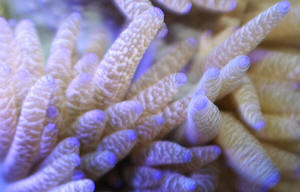
|
Re: Anemone ID
1/28/11
Well thank you very much Bob. I thought it looked different.
Well whatever it is, it's improved from see-through and
flat to a nice looking nem with color.
Thank you so much for the information. I read through the
articles ... no possibility it's dyed, because it looked
like milk glass when I got it. :)
Renee
<I do wonder what this animal is though! B> |
Re I need some information for an Anemone ID - Bob
Fenner Referral 1/31/11
Here is the information and my note from the person you referred
me to.
Her answer is included below as well as my letter to her
regarding my H. Crispa.
<Okay! Thank you and Daphne (hello!). BobF>
Thank you Bob for your help and I am sad that I can never
possibly provide the best home for him, but I am doing what I
can. I wish we weren't in California and/or the sea it came
from was near so I could let it go. It's so sad to see these
beautiful creatures dying so frequently in well-meaning hobbyist
homes. I
think if everyone stopped buying them, they'd stop shipping
them, but there's little/no chance of that happening.
I rescued it and it is alive and surviving. Maybe someday it will
have longer tentacles. I am adding some 10k T5HO to the system
today. Maybe this will give it a bit more light. Just to survive,
this guy wants 2 krill every morning, super bright light,
absolutely crystal clean water without any readings and water
changes every 7 days like clockwork. Without those, he looks
pekid.
I will do my best for it. I hope it survives. :)
Thank you and WWM for all the help,
Renee
From: Daphne Fautin
Subject: Re: I need some information for an Anemone ID - Bob
Fenner Referral 1/31/11
Dear Renee,
Knowing precisely what species of anemone you have is probably
unimportant in being able to care for it properly. Of course, I
am not an aquarist -- I am a field biologist and a taxonomist of
sea anemones. I prefer to see the animals where they live so I
can understand how they live. No matter how much we
try to emulate that environment in captivity, we will fall short
in some way because we do not have all the species, all the
chemicals, all the water motion, all the weather, etc. in our
tanks.
It seems to me that many of the shallow tropical anemones that
host Clownfishes live in pretty much the same types of habitats,
and so probably eat pretty much the same thing and have similar
physical requirements.
As to what you have, what is it about the animal that Bob Fenner
make your possible identification of it as *Heteractis crispa*
wrong? The tentacles are patterned, which is atypical, but
specimens from the Red Sea may have such patterning.
<<Mmm, I strongly doubt this animal was harvested from the
RS. VERY few come to the west from there. RMF>>
The main feature that distinguishes the species is the leathery
column (the source of the species name, and of course not
something I can judge) and the large verrucae (warts) on the
upper column, in longitudinal rows, which this seems to have, to
judge by your photos. These tentacles seem short for the species,
but that may be because of the conditions you described. Indeed,
typically individuals kept in captivity have shorter tentacles
than individuals of the same species in nature: sea anemone
tentacles grow from the base and cells die at the tips, so the
length is determined by the ratio in timing of the two processes.
The short tentacles of captive-kept anemones reflects to me that
they are not thriving -- their tentacles are not growing as much
before the tip cells die as in nature. It is one of the
indicators I use to back up my claim that something is missing --
and by this I do not mean that aquarists are doing something
wrong or are mistreating their animals. It is just that humans
cannot provide something the animals need, and I do not want to
see more animals taken (so they do not contribute to the next
generation of anemone or homes to
the next generation of Anemonefishes) in what I consider to be a
misguided effort to "solve" the problem. It might never
be solved, and even if it is, how many animals have to die in the
process?
Sincerely,
Daphne G. Fautin
Professor, Ecology and Evolutionary Biology
Curator, Natural History Museum and Biodiversity Research
Center
Haworth Hall
University of Kansas
1200 Sunnyside Avenue
Lawrence, Kansas 66045-7534 USA
direct to database of Hexacorals, including sea anemones
newest version released 22 December 2010
***http://hercules.kgs.ku.edu/Hexacoral/Anemone2***
> Hi,
> I know you must be busy, but I was referred to you by Bob
Fenner, who had no
> idea what kind of anemone I have. He has asked me to send
you images. So, I
> have uploaded them to Flickr, and you can see them there. I
thought this was
>H. crispa, but he says everything is wrong. So, maybe you can
help me out finding
> answers, so I can properly care for it. I have had it since
July, 2010. It was
> in a local pet store. I got him for ten dollars, because he
had lost all
> coloration and was white/glassy and had no tentacles.
Basically, the poor thing
> was an oral disk, and I think it might have been dying, but
it has taken a lot
> of care, lighting and it has come back somewhat. Here are
images of my
> anemone. I'd certainly appreciate your expertise, as I
have no clue what I've got.
> You can view the images I uploaded at
http://www.flickr.com/photos/fishdeeva/
> Thank you sincerely,
> Renee
|
|
Anemone Identification - Sebae? 12/2/10
Hello, and thank you in advance. You have been of help for me in
the past, and I want to thank you all for the time you donate to
help others, such as myself.
Your site has been a huge resource and has been so helpful.
<Very glad that we have helped you>
I purchased this anemone for a very big discount at my pet store.
He had been there two months. He was so white, he looked like
glass...see-through. His size initially, was about 1.5"
across and he was flat, without much of an extension where his
tentacles are. The petstore helper said that he had no idea
what
it was, but it had arrived as a Sebae, but had not had a good
time...he discounted it for $10 if I wanted it, and I took the
thing home.
Well, he has grown, and his coloration is increasing, slowly, and
I have had him about 3 months. He is now a light pinkish purple,
with bright blue tips.
<I see this... unusual coloring>
I would like to see his tentacles get longer, but they don't
seem to and they don't seem to be full as the bubble tipped
anemone I have had in another system.
This little thing is about 4" across, maybe 5", now and
it is not white anymore,
but it's still not dark, either.
<Will likely continue to change, intensify/darken with
time>
My system is under 250w HQI 20k lighting. He is approximately 1
foot from that bulb, and he is also given T5 lighting, as a
supplement, only the actinics, as I need to purchase new 14k t5ho
bulbs for the other two, however it is helping...not as fast as
I'd like to see it, but he looks improved.
I don't have any pictures of when he arrived, however, I have
some photos I snapped today which I'd like your opinion
on.
I have been through your entire site. I read all the differences
I could find between the H. Crispa and H. Malu. I still can't
identify him properly and in order to get him the right
clownfish, I'd like to have an idea what type I should be
searching out...I don't particularly like the Clarkii, so I
am hopeful he can accept other types.
<Yes, can>
I was thinking of a skunk pair...but let's see what you
determine him to be, and go from there.
<I do think this is a Heteractis crispa, a "Sebae"
as you state>
His tips aren't pink, they are blue.
<At least they are "dotted" at the tips; a
definitive characteristic>
His coloration is a very light lavenderish-tan,
<As I say, strange to me>
and he lives on top of the reef, and has finally adjusted to the
lighting after all this time, just this month. His hiding days
are gone, thank goodness. He, at first, soaked up light, and then
went into the reef and I
was afraid he had died, but he came out earlier this month and
continues eating Krill and Mysis Shrimp, and he is now up near
the light, soaking and enjoying it.
<Good>
I see him spread out more. My Maroon ignores him, although she
swims over and looks...she prefers my frogspawn over him,
therefore I am pretty sure it's a Sebae, but I really value
your opinion.
Thank you again, and I hope that you can help me identify
him.
Photo #1 is the anemone from the top of the tank, showing his
coloration, because the flash bleaches him out somewhat.
<Ah yes>
Photo #2 is from the side of the tank and yes, I see the algae
behind him...I am picking it out soon as I get this photo out to
you! Lol. :)
Renee
<Thank you for sharing. Bob Fenner>
|
|
 
|
|
Re: Anemone Identification - Sebae?
12/2/2010
Thank you so much for the response.
<Welcome... Muffin Top?>
I do have another question about health of this particular
anemone. Does it look like it's healthy to you, and if not,
what would you suggest to help bring him out of it?
<From your report and images, this specimen appears to be on
the up and up improvement wise>
I have been feeding him krill and Mysis. This week, I will chop
up fish and squid and freeze it for him, thinking this should
vary his eating schedule.
<Real good>
Also, I cannot seem to locate Saddleback Clownfish information as
to the particular anemone they like the best.
<See the chart here:
http://www.wetwebmedia.com/marine/inverts/cnidaria/anthozoa/anemones.htm
toward the bottom>
Would this anemone be for that clownfish?
<Very likely so... Clownfish species do quite often
adapt/adopt other species of anemones, even other groups of
organisms to host w/ in captivity>
Thank you,
Renee
<Welcome! BobF>
|
NZ Anemone ID, H. crispa 9/22/10
Hi Bob,
<Howdy Alois>
Wondering if you can help.
<Will try>
I am a importer in New Zealand.
Due to our silly restricted laws we are only allow certain species of
corals/fish.
<Ah yes... akin to Australia... you have a "clean list",
as opposed to the U.S. and its states w/ "dirty lists" of
banned organisms>
I have imported Heteractis Crispa anemones and our enforcement agencies
are saying that it is not allowed as it is not on the allowable
list.
<Yes, I've read this>
However our allowable list is outdated and it still has old names.
I have done some research and it appears that Heteractis Crispa use to
be identified as
<http://hercules.kgs.ku.edu/Hexacoral/Anemone2/check_synonymy.cfm?species=tuberculata&genus=Discosoma&subgenus=&subspecies=>
Discosoma tuberculata,
<http://hercules.kgs.ku.edu/Hexacoral/Anemone2/check_synonymy.cfm?species=macrodactylus&genus=Radianthus&subgenus=&subspecies=>
Radianthusmacrodactylus.Heteractis Malu, Actinia crispa
Our allowable list has the following species.
Radianthus sp
Actinia sp.
<Mmmm>
Would you consider these to be the same species?
<No my friend... the current scientific name supersedes these older
invalid (nomen nudum) ones>
Do you have any information that could help,
Regards
Alois
<I am sorry to report that the "Sebae" anemone IS
Heteractis crispa, not any other, older name. Bob Fenner>
Re H. crispa ID/NZ 9/23/10
Hi Bob,
<Alois>
It appears that Radianthus and Stoichactis are the old genus names for
host anemones, therefore no species should be referred to as a
Radianthus anemone.
<Yes, I concur>
H. crispa used to be R. kuekenthali, H. magnifica used to be R.
ritteri.
<Yes... among other names>
http://kielo.luomus.fi/laji/?t=Heteractis%20crispa&l=uk
http://www.netpets.org/fish/reference/reefref/heter2.html
http://www.reefsanctuary.com/forums/anemones/46958-these-possible-clownfish-anemone-combinations-2.html
regards
<And you. BobF>
|
Re: Anemone ID... Not dying 7/1/10
update
Hey all
I believe/hope my bleached anemone is recovering. I attached
before and after photos taken 6 weeks apart. I still am not sure
what kind it is. (my clowns seem to like it regardless)
Am I correct in thinking its getting better? Can it now be
identified?
Sebae?
Thanks for your help.
Steve
<Yes!, and likely Heteractis crispa. BobF>
|
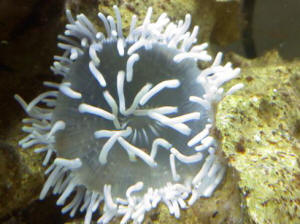 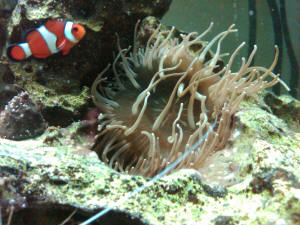 |
|
Heteractis Malu Or Heteractis Crispa/Anemone ID
3/3/10
Hey guys,
<Tyler>
Love your site and books!
<Thank you!>
Great resources, I'd be lost without them.
On to the anemone.
I thought it was a Crispa, but after reading your Malu section
there were some similar pictures to mine..... Now I'm
confused.
Is it a Heteractis Malu or Heteractis Crispa?
<After looking through Mr. Fenner's anemone scans, it
looks more like a Magnifica/Ritteri (photo attached), and a very
difficult specie to keep alive for any length of time. Mmm, what
color is the column?><<Mmm, am pretty sure... 95%
confidence limit, that this is a H. crispa here. RMF>>
Thanks
<You're welcome. James (Salty Dog)>
Tyler
|
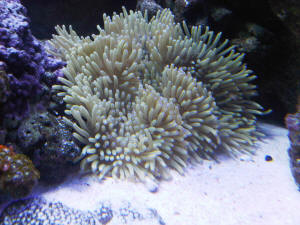 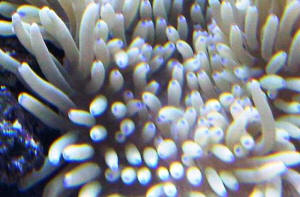 crop crop |
re: More re: Heteractis Malu or
Heteractis Crispa? 3/3/10
Thanks Bob, looked like a dead ringer compared to one of your
Magnifica photos. Looked like the Crispa has longer, slightly
thinner tentacles in comparison to the Magnifica, but I'm not
going to argue with experience. What traits led you to your
ID....very interested to know for future reference.
<Mmm, Magnificent's don't have "pink tips",
but do agree that for a leather, this specimen has a BUNCH of
tentacles. Cheers, BobF>
James
Re Heteractis Malu Or Heteractis Crispa/Anemone ID
3/3/10
Hi James,
<Tyler>
It is all the same color through out, a beige brown with bright
tips on the tentacles. Its attached itself to a rock very well and
hasn't moved yet.
<After talking with Bob re the ID, he would bet his last beer
that your anemone is a Crispa. It is unusual that a Crispa would
prefer anchoring to the rock rather than burrow into the sand,
unless it just appears to you that he is anchored to the rock.
The giveaway in ID'ing was that Magnifica's do not have
pink tips.
Regardless, Heteractis species are difficult to maintain in captive
systems.>
Thanks
<You're welcome. James (Salty Dog)>
Tyler |
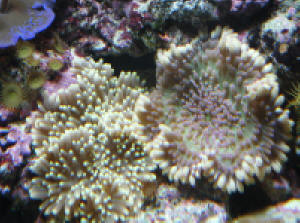
|
Re: Anemone ID
2/10/10
<... what is it with... 10 megs of pix?!>
The one anemone on the right hasn't found a spot to
settle yet.
<... READ, don't write>
The one on the left has never moved its location since I
put it there.
The one on the right (green and purple with tan edges)
landed in the corner towards the bottom but right up
against the glass so I was able to take a picture of it
from the side. I believe the other anemone looks the same
underneath as well. I know they don't have color, just
white with maybe a few small bumps. Any idea on a species
conformation with the new picture?
<Yes... a badly bleached, stung (and torn) Heteractis
crispa. See where you were referred to last time. These
animals should be returned. BobF>
Thanks
Kevin
|
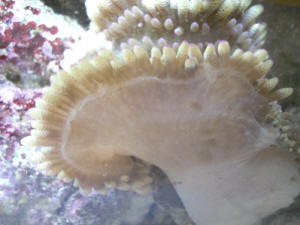 |
|
Sick Sebae Anemone, Not enough lighting. 12/2/07
Dear Crew, <Hello Sami, Brenda here> I read a lot of your answers
regarding anemones and the Sebae anemone in particular, but still have
2 questions regarding my Sebae that I got 2 days ago. It would be great
if you could comment. The first is whether or not I can touch the
anemone and turn it around (it has been upside down since noon today).
I read somewhere that this was a very bad position, as its tentacles
cannot breathe this way. But I also read that one should leave the
anemone alone as much as possible. So, should I turn it around (if so,
with my hands and gloves??). By the way, it is white (and I know I have
to get it brown and healthy now). I fed it mysis shrimp which were
sticking on its tentacles and it did eat. I intend to get Selcon also.
<It sounds like you have a very sick anemone. How was it acclimated?
You can try turning it over, but it is likely it will just turn it self
over again. I would definitely wear gloves.> The second question
concerns my lights: I have a 40 gallon breeder tank, so it's not
too deep (< 18"). I have the Coralife Lunar Aqualights (2x96
watts I think). I have the white ones on from 12:00 to 6pm and the
actinic on from 7AM to 8PM, the lunar lights from 8PM to 7AM. Is this
ok? <2x96 watts of PC lighting is not enough for this creature.>
FYI, I have 70lbs LR, a wet-dry trickle filter, an Aqua C protein
skimmer. I have two false clowns, a royal Gramma, a lawnmower blenny
and snails/hermit crabs/1 emerald crab, 2 conch snails. I have 2
mushrooms. The tank is 4 months old. <A 4 month old tank is not old
enough. Anemones need established environments, 6 months to one
year.> Salinity: 1.025 <1.026 is better.> temp: 78 Calcium:
420 Alkalinity: 4 <Im not sure what method you are using for
testing. See here: http://www.wetwebmedia.com/alkalinity.htm >
Ammonia/Nitrite/Nitrate: 0 Magnesium: 1200. <I would aim for the
1300 1500 range.> Thank you guys so much! Regards, Sami <Youre
welcome! Brenda>
| Anemone Question (possible H. crispa) 8/22/05 Hello
again Crew, and thank you for your patience. I have a question
regarding an anemone that I would like to add to my tank, mainly
with regards to lighting. This particular individual is a
Heteractis crispa or malu, and is a pale white/gold with purple
tips to his tentacles. Our LFS recently acquired him, and will hold
him for another 2 weeks for us. <With a decent reference, H.
Crispa and H. Malu should be fairly easy to distinguish. I am
guessing this is probably H. Crispa because it is more common and
very prone to bleaching (which this one sounds like it is). H.
Crispa is fairly hardy (by anemone standards) if a healthy specimen
is acquired and is successfully acclimated. Bleached specimens
often fail to survive. Observe this one for evidence that it is
repopulating zooxanthellae before buying. Healthy specimens
aren't always beautifully colored, but they should not be
white, pale or "washed out" looking.> I have a 75
gallon tank that is 48L x 24H x 18W, with 62lbs live rock (buying
more as I go). I use an Aqua C Remora Pro with a mag drive 3, and
have a sump with carbon and Chemi-pure. Am: 0 NO2: 0 N03: <3ppm
I do a 10 gal water change every two weeks. Sounds good. pH,
Alkalinity and Calcium should all be maintained in their normal
ranges and salinity should be 1.025-1.026 for anemones.>
Lighting is: 2 65 watt PC 10,000K and 2 65 watt PC Actinic. These
are suspended 3" above the water, no cover glass. Will this be
enough light if the anemone is placed in the top half or third of
the tank, or should I invest in a MH bulb? I have seen the clip-on
halides, are these effective? I plan to quarantine the anemone for
4 weeks also, after 2 more weeks at the LFS. This will be in a
15gal tank, would a clip on MH work here also? <I would suggest
at least 50% more light (double would be better). You could
accomplish this with more PC's or a MH. I am not sure what you
mean by clip-on MH, but most fixtures offered for the aquarium
trade are suitable.> As to the general health of the anemone,
I'm not sure if it is bleached, or just a pale specimen. I am
going to look more closely in the morning, would it be helpful to
you if I sent a picture to get your opinion? Thank you for your
excellent site, and all of your help. Benjamin Kratchmer
<Pictures are always beneficial, but you have presented a very
classic situation. H. crispa is commonly imported, more often than
not they are bleached, and occasionally dyed (Bright yellow is not
a natural color for H. Crispa and a sure tip off that the animal
has been dyed!). If after two weeks, this anemone starts developing
a richer cream or green color, is expanding well and shows no signs
of physical injury, it is probably a safe bed. Be sure to feed it
small bits of meaty foods every few days, especially as it
recovers. Best Regards. AdamC.> |
|
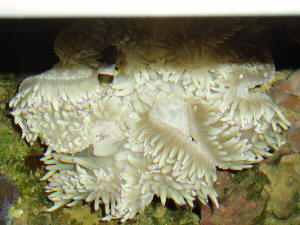 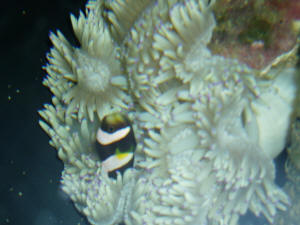
|
| Anemone Question (possible H. Crispa) part2 8/29/05
Sorry, I didn't get the photos on that one....oops. <No
worries. Does look like H. Crispa. It is definitely bleached, but
looks to be in otherwise good health. Feed small a couple of small
pieces (the size of a marble or so) of food twice a week until it
recovers. Best Regards. AdamC.> |
Anemone Conundrum, lack of knowledge Hi Gang, <Hello>
First, let me describe my setup. I've got a 125G SPS tank with
about 9 watts per gallon of 20K MH and actinic PCs. I am collecting the
rarest frags I can get, making it somewhat of a collector's tank.
<Okay> The reason for the email is that a lady has stolen my
heart, and she is a beautiful bright yellow sebae anemone. <Mmm,
she's a phony... a dyed animal> They call her the 'flaming
sun' sebae. I have heard conflicting reports of anemones stinging
SPS corals, and LPS for that matter. On the other hand, I've seen
lots of successful reefs with a mixture of SPS, LPS, and an anemone or
two. Thoughts on adding a sebae in particular, or is their a better
choice? Thanks, Brandon Wilson <Please see here: http://www.wetwebmedia.com/coloredanemones.htm and the other
archived materials on Heteractis crispa/Sebae anemones... And don't
perpetuate the practice by endorsing it (buying such doomed animals).
Bob Fenner> HELP!! Yellow <Dyed> Sebae Anemone James,
Okay, I understand the feeding issue. But I was wondering if there IS a
such thing as a yellow sebae? <I've heard of them> Like I
said his foot is yellow too. <<No... this is a dyed specimen...
RMF>> I put him in a 3 gallon bowl with bubbler, live rock (which
he attached to right away) and sand. <He will not be with you very
long in a three gallon bowl. They need much larger quarters and plenty
of moving water and intense lighting to survive.> I put him in the
sun in my daughters room and when we got home last night he looked a
lot happier. This morning her room was chilly and the water was 76, so
we currently have him back in the sun on the patio with a thermometer
to watch the temp. I noticed a clear slime that is coming out of his
pursed little mouth (not gaping like yesterday) I have a gallon of
fresh salt water to swap out when he is done "sliming". What
is that? <Please do a google search on the Wet Web, keyword
"sebae anemones". You should know what their requirements
are.> Also, in an unrelated question, what else do spotted snake
eels eat besides ghost shrimp? He will eat out of my hand, but does not
like Mysis or brine soaked in Zoë. <Read
here. http://search.hp.netscape.com/hp/boomframe.jsp?query=Spotted+Snake+eel&page=1&offset=1&result_url=redir%3Fsrc%3Dwebsearch%26requestId%3D3ea67cb9c10fc109%26clickedItemRank%3D9%26userQuery%3DSpotted%2BSnake%2Beel%26clickedItemURN%3Dhttp%253A%252F%252Fwww.wetwebmedia.com%252Fophichthidae.htm%26invocationType%3D-%26fromPage%3DNSISPTop%26amp%3BampTest%3D1&remove_url=http%3A%2F%2Fwww.wetwebmedia.com%2Fophichthidae.htm
> Also, I tripped across a blurb about not having anemones with
coral?? <It's not a good idea but people do it.> I have a
peppermint and 1 zoo, and 1 Ricordea mushroom (who will NOT attached to
anything to save its life! Dumb Mush!)<Not unusual> Thanks,
<You're welcome. James (Salty Dog)> Carrie :) PS; Is indirect
or direct sunlight better for the sebae? And for how long?
<10-12
Sebae Anemone Let me start by saying that
your site is the best site I have seen for aquarium junkies such as
myself and I thank you for that. <Thank you, WE all owe it to
Bob> This is the anemone I purchased at the LFS. I think it is a
sebae but not for sure, I sent along two different pictures to show
what it looked like when I got it and what it looks like now.
<Only one came through> <Judging by the one picture
I got to open I would say you're correct, this is a sebae.>
It seems to be doing fine and is turning a light brown which I read
is a good thing. <Yes it is gaining zooxanthellae algae which
are photosynthetic and help to feed the anemone.> It seems to
turn darker brown at times but stays a lighter brown or tan most of
the time. <This is normal and is fine.> I have been feeding
it small silver sides. I recently asked another LFS what else I can
feed it and they told me to feed DT's Phytoplankton and give a
couple drops of Coralife's Invertebrate Target Food every other
day. My question is that when I feed the target food the anemone
opens its mouth real wide and in the area where I place the drops
the tentacles seem to shrink up and turn dark purple, they only do
that for a few seconds and then return to normal. Does that seem
right... <I am not sure, as I have not used this product. The
anemone needs fine meaty foods like silversides and maybe some
shrimp or other meaty foods that are finely diced or in frozen cube
form, let them break apart in a bowl for the frozen cubes then use
a turkey baster, or use a powerhead on low and put the cube on the
intake port and as it break up it will blow out near the anemone
and the current will get it there.> ...or does the anemone not
like the target food? My other question is if I feed the
phytoplankton is that enough to support the anemone or do I still
need to feed silver side etc...? <Feed the silversides every 3-4
days or at least weekly, and you don't need the phytoplankton.
Anemones need meaty foods to survive.> Thanks in advance for the
help... Mike
<No Problem. Justin (Jager)> |
|
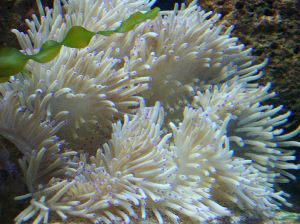
|
| Anemone ID I think it is a Sebae but my
brother thinks its a magnificent? Thank you! <Picture is very
out of focus for accurate ID but it looks like it may be a
Heteractis crispa, same family the Sebae Anemone belongs to. James
(Salty Dog)><<Actually, not family... the Sebae IS the
same species... this is one common name for H. crispa. See... on
WWM. RMF>> |
|
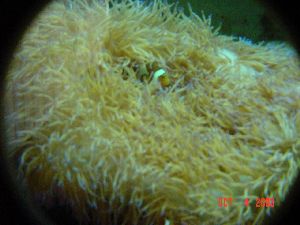
|
Anemone ? What is the name of this Anemone
what the best thing to do to keep it healthy. this is not my pic I
tuck it of the internet it did not give the name but it is what I
have in my 55 gal tank I am a beginner. in need of knowledge.
<It appears to be a Heteractis crispa, what in the trade is sold
as a "sebae anemone". Please see here re:
http://www.wetwebmedia.com/marine/inverts/cnidaria/anthozoa/anemones.htm
and the linked files (at top, in blue) beyond. Bob Fenner>
Thank Steven |
|
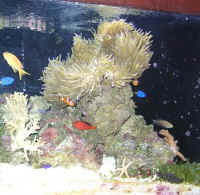
|
Anemone of some kind? 12/3/03 I have sent you questions
recently about ich. I have moved all fish to the QT tank as per your
recommendations. The fish are fine by the way. <very good to
hear> Quite a challenge to get them though, all the live rock had to
be removed. The corals had to be placed at the bottom of the tank to do
this though. I damaged my open brain coral. I am not sure how I did it.
I noticed a small tear in the outer parts of the fleshy parts of it
(not good) to say the least. I have not had much luck with restoring
damaged corals back to good health. < largely a matter of good water
flow... keep this coral on the sand bottom in this case (natural...
never on rock)> I have been given 4 by my LFS that were in bad
shape. They all have perished in my QT. My question is what I do about
the brain coral. <Hmmm... Trachyphyllia is actually a very hardy
coral. It needs to always be kept on soft substrates... and if fed 3-5
times weekly is one of the most hardy LPS corals. Truly a beginner
species. I suspect lack of feeding here for this very hungry coral>
Obviously I cannot move it to the QT tank as there are copper meds in
it. And to make matters worse my wife bought some kind of anemone
today. <ughhh! please do not mix anemones with corals. Motile
cnidarians with sessile cnidarians is a recipe for disaster. At best,
keep this anemone in an inline refugium... and not in the display
proper. A separate tank would be better. A 20G by the window might even
be fine> I have no idea what kind it is. It looks like a carpet of
some kind. Please let me explain what it looks like. It is cream
colored with short stubby tentacles. Each tentacle is tipped with a
blue or purple dot. It is round when it is fully extended (hence why it
looks like it might be a carpet) Rather pretty I must say. <my guess
from the description is that it is a (commonly) bleached Sebae anemone
(they are white/yellow with purple tips when bleached) and it needs
extra special care to recover to a healthy brown color if it is to have
a prayer of surviving. Shame on your LFS for selling this if
so/true.> But I have no idea how to take care of it. <please look
at the picks and descriptions of sebae anemones and others in our
archives and FAQs at wetwebmedia.com. Use the google search tool on the
home page for a fast hit of links> And I have common anemones in the
tank already. <ughh... you are killing me <G>> Chemical
warfare will become a problem. <ahhh... yes> I already fight this
with all the corals I have. <BINGO... you win the hairy kewpie
doll> Really aggressive skimming and frequent water changes have
been good so far for that. 3+ years. Fish are relatively new additions.
I added them about a year and six months ago. Never had ich until this
week. Still not sure were it came from as I quarantined them for about
5 weeks, before I added them. Thanks yet again for your help. Craig B
<wishing you the best of luck and return to good health for the
system. Anthony>
Another Bleached Sebae Anemone :( - 11/22/03 Hi, we recently
added an anemone to our tank. We've had it for about 3 days. This
morning I looked at the tank and it had a "ball of stuff"
coming out of the middle of it. As the day went on, it kept coming.
I've attached a couple of pictures of it. Any ideas?? Thanks for
you attention! Erika <this is a common reality/problem my friend.
Your anemone is dying... and it was not a good candidate from go.
Frankly (not berating you), your merchant should have known not to sell
this animal and you should have known not to buy it (as an educated
consumer... research your livestock's needs before you buy them).
This species of anemone is naturally dark in color (usually brown) with
dark purple tips. Yellow is not a natural color and indicated an animal
that is bleached and/or has been dyed. It will be dead within days. Few
live weeks beyond import. I really don't know why merchants pay for
these things when they are shipped to them. If they stopped paying for
them and if consumers would stop buying them, then the collectors would
get their acts together and stop shipping them unhealthy. Please read
more about anemone health and car in our archives. Be sure to follow
the links at the top of the page too. Best regards, Anthony
http://www.wetwebmedia.com/marine/inverts/cnidaria/anthozoa/anemones.htm
http://www.wetwebmedia.com/marine/inverts/cnidaria/anthozoa/sebaeanefaqs.htm
http://www.wetwebmedia.com/sebaefaq2.htm
http://www.wetwebmedia.com/marine/inverts/cnidaria/anthozoa/anemonelightngfaqs.htm
http://www.wetwebmedia.com/anemonelgtgfaq2.htm
http://www.wetwebmedia.com/marine/inverts/cnidaria/anthozoa/anemonehealthfaqs.htm
http://www.wetwebmedia.com/marine/inverts/cnidaria/anthozoa/anemoneselfaqs.htm
Recovering anemone... No such thing as White or Yellow Sebaes!!!
9/30/03 I have a sebae anemone that used to be white with purple
tips. Several months ago I moved the entire tank and now the anemone is
always a light brown color. It looks like it's growing and healthy.
I also have 2 clown fish. Is it healthy or should this anemone be
white? Thank you, Erin <you are very fortunate... the brown color is
the recovering zooxanthellae of a bleached animal. Sadly, most sebae
arrive in the country as white or yellow... and there is no such thing
practically in the wild... they are bleached and likely to die. You
have a survivor. With weekly feeding by you, it will get browner and
fare well. Read more about this phenom in our wetwebmedia.com archives
under anemone topics. Best regards, Anthony>
Shedding Some Light On Anemone Coloration? I have a Sebae
anemone that used to be white with purple tips. Several months ago I
moved the entire tank and now the anemone is always a light brown
color. It looks like it's growing and healthy. I also have 2 clown
fish. Is it healthy or should this anemone be white? Thank you, Erin
<It could be a function of the light that the animal is exposed to.
The concentration of zooxanthellae in the animal's tissues can
influence the color. Colors can vary widely in these animals. Other
times, they can be a response to stress. In your case, because the
anemone is feeding and responding normally, I'd think that it's
a response to lighting. Perhaps the animal needs more light. The
zooxanthellae may be concentrated in the tissues as a response to lower
lighting than it is receiving. Try increasing the lighting a bit, and
see how the animal responds. Regards, Scott F>
| Anemone Identification and Over skimming? Hi
there, <Hello> Great site, Just want help in identifying my
anemone. Since I bought it it has been this colour but I got if
from a display tank at my LFS in Singapore. It was already with a
Golden Maroon Clown and so I bought it too. <This is a bleached
out Heteractis crispa, most often called a Sebae Anemone in the
trade in the west> The clownfish has grown but the Anemone has
begun to not open fully and its tentacles are not fully extended.
This started to occur after I bought a much larger skimmer. Is it
related? <Not likely. Take a read over the Anemone FAQs on
WetWebMedia.com... very common for bleached out (lacking
endosymbiotic zooxanthellae due to mishandling, being kept w/o
adequate light...) Sebaes to perish slowly> My green button
polyps and mushrooms are doing fine and I have had them for a year
now. I feed the anemone squid and occasionally target feed it with
Liquifry Marine. Heard its good stuff. Anyway it takes the food and
it seems to open a bit larger then resumes its previous smaller
state. I have read that it is common for anemones to occasionally
deflate and this is the first time mine has done this apart from
when it was first introduced into my tank. Should I worry? <Yes.
What you state is so, but in this case, these specimens rarely
"rally", but this is not altogether the case. Some
crispas reincorporate flagellated algae, regain color, health>
My clown is about 2 inches long and it spends the better part of
the day trying to force itself into the Anemone using his snout to
pry it open. <Yes, likely not adding to the health of the
anemone either> The anemone was white since the day I saw it but
after a month or so in my tank, the tips became brownish but have
since become white again. Is there a way to aid it in replenishing
its zooxanthellae? Or is this creature on its way out? <Ahh, I
see you know of the situation already. If your system is otherwise
"healthy" and you have other zooxanthellate animals
present, enough light... maybe> My pH is 8.2 - 8.3 My
temperature is approx 29 Degrees Celsius - Is this too high for
softies? <Not most that folks keep> My nitrates are
undetectable Tank is a 15 gallon <Fifteen gallons? This is quite
small... much greater chances of success, disaster-proofedness with
larger volumes> Regular water changes New oversized skimmer My
copepods cannot be seen anymore on the glass or LR 2 fish are doing
fine Clown and fire goby Turbo snail does his daily rounds.
Lighting is 36 Watts 1 marine white 1 marine blue, both from
arcadia <Your anemone needs much more light, by more than
twice> 1 sweeping wave maker 3 stalks of mangroves <In this
15 gallon system?> My 2 shrimp (1 blood, 1 skunk) died while
molting, heads were semi detached - or could be clownfish. I do
regular weekly water changes ~ 10% I add calcium, trace elements
and buffer on a weekly basis. Please help me! <Mmm, is there a
chance you might be getting a larger system... perhaps to match
your skimmer? You really need this foremost. Bob Fenner> |
 |
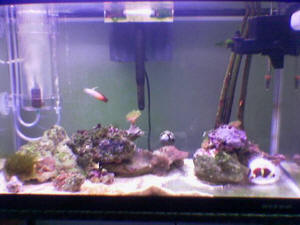 |
Help identifying an anemone I have been searching the web for
over a week now trying to find some information that will match. I
recently purchased a sebae anemone (Heteractis crispa) from a local
shop, and after getting the critter home, went on a mass information
search. Good quality images have been hard to find, but the anemone I
have looks pretty identical to the one listed at
http://www.marinedepotlive.com/1123874.html. My trouble is I have seen
similar looking anemone's classified as bubble and sebae. <The
animal shown is H. crispa, sold in the trade most often as a/the Sebae
Anemone> On the majority of non shop sites, the Sebaes are shown
with much longer tentacles and darker colors. <This is indeed what
they look like in the wild... consequent with their collection is
(almost always) a loss of endosymbiotic algae (the source of color)>
Unfortunately, the lack of quality images on the hobby sites, has left
me wondering what exactly I do have. I'm just under a year into
this hobby and this is my first anemone, and I'd really enjoy
seeing him thrive. Thanks for your generosity with your time and
knowledge. <Thank you for writing. Please see here:
http://www.wetwebmedia.com/anemones.htm and other Anemone articles,
FAQs posted. I have many images of this species, some bizarrely colored
(by humans) for sale in the hobby. Bob Fenner> Benji Re: Anemone
ID Steven, It really doesn't look like a sebae. The purple dot
on the tip is the size of a pinhead and very uniform in size.
Wouldn't dying affect that? Craig <No, generally the dye is only
absorbed by the rest of the tissue and the purple tips are unaffected.
Look through the WWM site. Bob has a ton of pictures there are
comparison to your individual. -Steven Pro>
|
|

